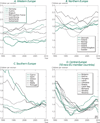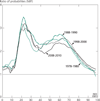Recent Demographic Developments in France: Relatively Low Mortality at Advanced Ages
- PMID: 24285939
- PMCID: PMC3839870
- DOI: 10.3917/pope.1204.0493
Recent Demographic Developments in France: Relatively Low Mortality at Advanced Ages
Abstract
France had 65.3 million inhabitants as of 1 January 2012, including 1.9 million in the overseas départements. The population is slightly younger than that of the European Union as a whole. Population growth continues at the same rate, mainly through natural increase. There are now more African than European immigrants living in France. Fertility was practically stable in 2011 (2.01 children per woman), but the lifetime fertility of the 1971-1972 cohorts reached a historic low in metropolitan France (1.99 children per woman), nevertheless remaining among the highest in Europe. Abortion levels remained stable and rates among young people are no longer increasing. The marriage rate is falling and the divorce rate has stabilized (46.2 divorces per 100 marriages in 2011). The risk of divorce decreases with age, but has greatly increased among the under-70s over the last decade. Life expectancy at birth (78.4 years for men, 85.0 for women) has continued to increase at the same rate, mainly thanks to progress at advanced ages. Among European countries, France has the lowest mortality in the over-65 age group, but it ranks less well for premature mortality.
Keywords: European comparisons; France; abortion; age structure; causes of death; demographic situation; divorce; fertility; marriage; mortality.
Figures


















Similar articles
-
Eastern Europe: pronatalist policies and private behavior.Popul Bull. 1982 Feb;36(6):1-49. Popul Bull. 1982. PMID: 12338315
-
[African population growth: status and prospects].Tiers Monde. 1991 Jan-Mar;32(125):159-73. Tiers Monde. 1991. PMID: 12283847 French.
-
[Demographic trends in Europe].Futuribles. 1993;(175):43-55. Futuribles. 1993. PMID: 12288216 French.
-
The fall of marital fertility in nineteenth-century France: exemplar or exception? (Part I).Eur J Popul. 1985 Jan;1(1):31-60. doi: 10.1007/BF01796917. Eur J Popul. 1985. PMID: 12159012
-
Annual summary of vital statistics--1995.Pediatrics. 1996 Dec;98(6 Pt 1):1007-19. Pediatrics. 1996. PMID: 8951248 Review.
Cited by
-
Second Unions Now More Stable than First? A Comparison of Separation Risks by Union Order in France.Eur J Popul. 2016 Mar 10;32(2):293-321. doi: 10.1007/s10680-016-9376-2. eCollection 2016 May. Eur J Popul. 2016. PMID: 30976216 Free PMC article.
-
Gray divorce among migrants and non-migrants in Norway: trends and implications for mental healthcare use.J Gerontol B Psychol Sci Soc Sci. 2025 Jul 25;80(8):gbaf118. doi: 10.1093/geronb/gbaf118. J Gerontol B Psychol Sci Soc Sci. 2025. PMID: 40576482 Free PMC article.
-
Fertility of Women Treated during Childhood with Triptorelin (Depot Formulation) for Central Precocious Puberty: The PREFER Study.Horm Res Paediatr. 2020;93(9-10):529-538. doi: 10.1159/000513702. Epub 2021 Mar 26. Horm Res Paediatr. 2020. PMID: 33774631 Free PMC article.
-
Contraceptive paths of adolescent women undergoing an abortion in France.J Adolesc Health. 2012 Apr;50(4):389-94. doi: 10.1016/j.jadohealth.2011.07.013. Epub 2011 Oct 7. J Adolesc Health. 2012. PMID: 22443844 Free PMC article.
-
City-Specific Spatiotemporal Infant and Neonatal Mortality Clusters: Links with Socioeconomic and Air Pollution Spatial Patterns in France.Int J Environ Res Public Health. 2016 Jun 22;13(6):624. doi: 10.3390/ijerph13060624. Int J Environ Res Public Health. 2016. PMID: 27338439 Free PMC article.
References
-
- Aouba A, Eb M, Rey G, Pavillon G, Jougla E. “Données sur la mortalité en France : principales causes de décès en 2008 et évolutions depuis 2000”. Bulletin épidémiologique hebdomadaire. 2011;22:249–255.
-
- Bajos N, Bohet A, Le Guen M, Moreau CAnd The FÉCond Team. “Contraception in France: new context, new practices?”. Population and Societies. 2012;492 http://www.ined.fr/fichier/t_publication/1606/publi_pdf2_pesa492.pdf.
-
- Barbieri M. “La mortalité infantile en France”. Population. 1998;53(4):813–837.
-
- Beaumel C, Pla A. La situation démographique en 2010. Mouvement de la population. Vol. 131. Insee Résultats, Société; 2012. p. 304. http://www.insee.fr/fr/ppp/bases-de-donnees/irweb/sd2010/dd/pdf/sd2010_b....
-
- Beaumel C, Bellamy V, Pla A. Statistiques d’état civil sur les naissances en 2011. Insee Résultats, Société; 2012. p. 134. http://www.insee.fr/fr/publications-et-services/irweb.asp?id=sd20111.
Grants and funding
LinkOut - more resources
Full Text Sources
